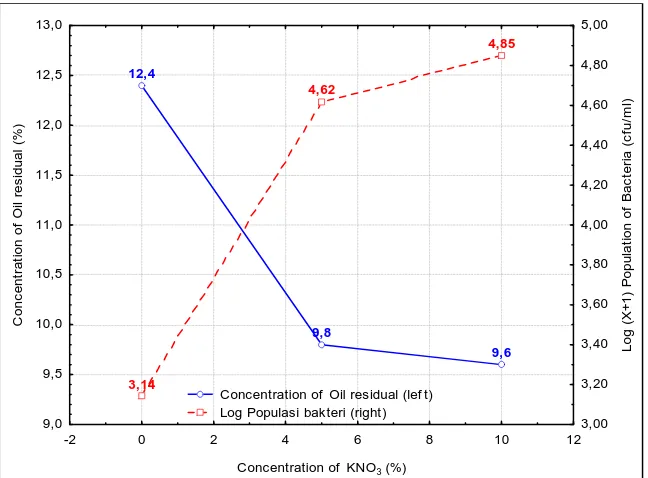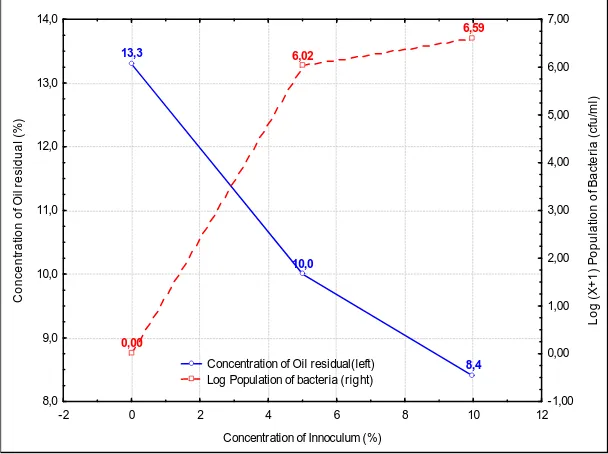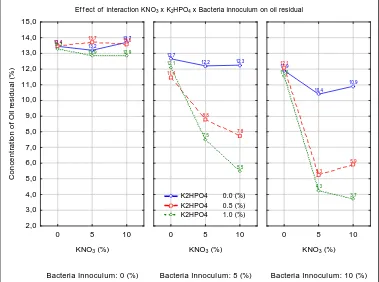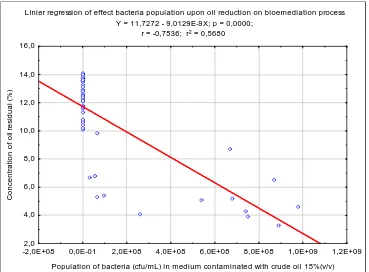ROLE OF NUTRIENT AND BACTERIA IN REDUCTION OF OIL IN BIOREMEDIATION OF WASTEWATER FROM OIL REFINERY INDUSTRY
Munawar1) and M. Said2)
1) Biology Department, Mathematics and Natural Science Faculty, Sriwijaya University 2) Chemical Engineering Department, Engineering Faculty, Sriwijaya University
Campus UNSRI Inderalaya
Jl. Raya Palembang – Prabumulih KM 32 Inderalaya Ogan Ilir, South Sumatra e-mail: [email protected]
Abstract
Research concerned with role of nutrient and bacteria as biological agent in reducing oil concentration in waste water of oil refinery industry has been done. The aim of research was to investigate the effect of nutrient addition such as KNO3 and K2HPO4 as well as, bacteria as
biological agent in reducing oil concentration in the waste water of oil refinery industry. The research was conducted by adding KNO3 and K2HPO4 nutrient with various concentration in
the waste water. Bacteria were inoculated into the waste water and it was incubated for 15 days. Bacterial population and concentration of oil after treatment were analyzed. Data analysis was treated using Analysis of Variance at significant level of 5%. Result of the research showed that addition of KNO3, K2HPO4, and bacteria inoculum’s influenced the
bacteria population and concentration of oil at the end of treatment of bioremediation process.
Key words : Nutrient, Bacteria, Bioremediation, Wastewater, Refinery Industry
INTRODUCTION
Oil industry up to now still becomes important industry at energy field. The industry is
divided into two parts, that is upstream and downstream industry. The upstream oil industry
conducts exploration to produce crude oil. It is transferred to downstream oil industry as
known as refinery plant to treat the crude oil into various fuels.
In spite of oil refinery industry produces petroleum products, it also produces waste such as
wastewater. The wastewater discharged from the oil refinery still contains residual oil. The
residual oil still contains hydrocarbon that could achieve 15%. The residual oil in the
wastewater can cover the surface water and it can prevent oxygen diffusion into the surface
water so that it can disturb aqua biotic in the water body.
One of efforts to reduce impact resulted by the residual oil is through bioremediation before
in the wastewater. One of nutrient added in the waste water is source of N and P. The
compounds added as source of N and P are KNO3 and K2HPO4 (Munawar, 2000).
Besides addition of nutrient, biological agent with hydrocarbonoclastic property is also added
in the wastewater. Addition of isolate of indigeneous bacteria in bioremediation process of
oily contaminated soil can reduce concentration of hydrocarbon in terms of Total Petroleum
Hydrocarbon (TPH) along the bioremediation process (Munawar, 2001)
The purpose of the research is to acknowledge the effect of nutrient of KNO3 and K2HPO4 as
source of N and P in bioremediation process to oil concentration in the wastewater and to
acknowledge the effect of addition of hydrocarbonoclastic bacteria inoculum to the oil
concentration and bacterial population after bioremediation process.
MATERIALS AND METHODS
Experimental setup and laboratory conditions
The experimental design consisted of twenty seven treatments with three factors: (1)
concentration of KNO3 as nitrogenous sources (0%, 5%, and 10%), (2) concentration of
K2HPO4 as phosphorus sources (0%, 0.5%, and 1%), and (3) concentration of inoculants
(0%, 5%, and 10%). Each of these treatments was replicated two times. A total of 54
experimental units were placed in a completely randomized design in the laboratory condition
(Modified Steel, and Torrie. 1981). For each experimental unit, a total of 100 ml of
wastewater contained 15% oil was added to flash and incubated at room temperature with
shaker 100 rpm during 15 days.
Measurement of Oil Concentration and Population of Bacteria
Measurement of oil concentration was conducted using gravimetric method, so
that the oil content can be determined in percent unit (Modified Neumann, et. all. 1981),
while bacterial population was measured with method of Total Plate Count (TPC), that is
method to calculate life bacterial so that the amount of bacterial population can be known in
the wastewater in unit of cfu/ml (Colome, et. all., 1986).
Statistical Analysis
Concentration of oil and bacterial population was analyzed using analysis of variety, If the
analysis showed the significant results, it was continued with Duncan test. All tests were
RESULTS AND DISCUSSION
The effect of each KNO3 on oil residual and population of bacteria
The effect of addition of nutrient of KNO3 to oil concentration and bacterial
population in bioremediation process held for 15 days was shown at Figure 1. Addition of
KNO3 reduced the oil content, while it had effect in increasing the bacterial population.
Reduction of the oil content due to addition of KNO3 was 21% to 23%, while the increase of
population of bacteria was 47% to 54%.
As shown in Figure 1, higher concentration of KNO3 had tendency to reduce more
oil concentration and to increase the bacterial population. The phenomena can be explained
that addition of KNO3 in bioremediation process is optimization process by adding N source
as nutrient. With addition of N, the required N for metabolism process and bacterial growth
increase, therefore the population of bacteria in bioremediation process increase. The
condition of high bacterial population will increase the bioremediation performance so that oil
content at the end of bioremediation process reduces. It was suitable with opinion of Wrenn
et. all. (1994 ) saying that N was one of necessary nutrient for bacteria to degrade
Concentration of Oil residual (lef t) Log Populasi bakteri (right)
Figure 1. Graph show effect of nutrient addition (KNO3) on oil residual and Population of
Bacteria requires N for metabolism of protein. It is divided into two groups, that is
structural protein that has function to arrange the cell component, and functional protein that
has role in degrading substrate such as hydrocarbon in the oil as source of carbon and energy.
If the requirement of N for bacteria is fulfilled, enzyme synthesis for degradation of
hydrocarbon also increases. The degradation activity increases so that the hydrocarbon
concentration will reduce along the bioremediation process.
The effect of each K2HPO4 on oil residual and population of bacteria
The effect of nutrient addition in terms of K2HPO4 to oil concentration and
population of bacteria along 15 day bioremediation process was shown in Figure 2. The effect
was similar to that of addition of KNO3 to the oil content, that is to reduce the oil content and
to increase the population of bacteria. The reduction of oil content due to addition of K2HPO4
was from 17% to 24%, and the increase of population bacteria was 38% to 48%.
Figure 2 also showed similar tendency with the effect of KNO3, that is higher
concentration of K2HPO4, the oil content was less, and population of bacteria increased. It can
be explained that K2HPO4 is nutrient required by bacteria for metabolism and growth. The
compound provides source of P for the bacteria. With addition of P, requirement of P for
metabolism and bacteria growth increase. The condition will increase population of bacteria
in bioremediation process. High population of bacteria will increase the performance of
bioremediation so that the oil content at the end of bioremediation process decreases.
12,3
Concentration of Oil residual (lef t) Log Population of bacteria (right)
Figure 2. Graph show effect of nutrient addition (K2HPO4) on oil residual and Population of
Utilization of P for bacteria is in the form of phosphate group for arranging DNA
aor RNA. One of arranging DNA was phosphate group, DNA will be replicated when cell
growth, while RNA will be transcription at process of expressing gen including gen being
responsible for hydrocarbon breakup along metabolism of hydrocarbon. Therefore P is
required by bacteria along its growth and enzyme production for degradation process of
hydrocarbon. According to Margesin and Schinner, (2001), the fulfillment of nutrient as
source of P can be conducted by biostimulation, that is by adding nutrient along the
bioremediaton process.
The effect of each Bacteria innoculum on oil residual and population of bacteria
The effect of addition of bacteria innoculum to oil concentration and bacterial
population is shown in Figure 3. Reduction of oil content due to addition of bacteria ranges
from 25% to 37%. The reduction of oil content was explained by Whittenbury, (1971). Oil
contained hydrocarbon compounds utilized by bacteria as substrate for carbon and energy
sources.
High concentration of bacteria innoculum provided will increase bacterial
population. Innoculum provided in the bioremediation process is initial population of bacteria.
If it provided in great number, its growth rate will be faster so that bacterial population in the
bioremediation is high. Log Population of bacteria (right)
According to Munawar (2000, bacteria in bioremediation process is important component
determining the success of bioremediation process.
Bacteria as biological agent is equivalent with engine in industry that changes substrate into
product. In process of bioremediation, bacteria acts as the engine to degrade pollutants tobe
compounds with less toxicity.
The effect of interaction KNO3 x K2HPO4 x Bacteria innoculum on oil residual and
population of bacteria
The interaction effect of the three treatment factors to oil concentration and
population of bacteria at the end of bioremediation process is shown at Figure 4. It can be
seen that interaction of addition of KNO3 10% x K2HPO4 1% x innoculum addition 10% is
able to reduce the oil concentration up to 3.7% or reduction of 68%. The concentration is the
lowest concentration of oil when it is compared with interaction of the three treatment factors
at all levels. The effective interaction for reduction of oil content in wastewater from refinery
industry is by addition of KNO3 10%, K2HPO4 1%, and concentration of innoculum 10%.
Ef f ect of interaction KNO3 x K2HPO4 x Bacteria innoculum on oil residual
residual in medium contaminated with crude oil
The effect of the three treatment factors to bacterial population is presented in
10%. The interaction of the three treatment factors at the level is able to increase bacterial
population up to 8.5 x 108 cfu/ml (46%). Therfore, the interaction is used to increase the
bacterial population in bioremediation process.
Based on results in Figure 4 and 5, different effective treatment combination exist
between effectiveness in reducing the oil concentration and that in increasing the bacterial
population. The difference relates to factor of nutrient addition of KNO3. The effective
concentration of KNO3 in reducing the oil concentration is 10%, while that in increasing
bacterial population is 5%.
Ef fect of interaction KNO3 x K2HPO4 x Bacteria innoculum on Bacteria population
Bacteria Innoculum: 0 (%)
Figure 5. Graph show effect of interaction KNO3 x K2HPO4 x Bacteria innoculum on Bacteria
population in medium contaminated with crude oil
As shown in Figure 6, bacterial population has positive correlation with the oil
concentration reduced with coefficient of correlation r = 0.7536, and coefficient determination
r2 = 0.568. It means that bacterial population in reducing the oil concentration is
bioremediation is 56.8%, while 43,2% is effected by other unknown factors in the research.
One of factors effecting reduction of oil concentration is time required for the
bioremediation process. The time of bioremediation process used in the research is 15 days
time for the bioremediation process. If it prolonged, the oil concentration might be lower at
the end of bioremediation process.
Linier regression of effect bacteria population upon oil reduction on bioemediation process
Y = 11,7272 - 9,0129E-9X; p = 0,0000; r = -0,7536; r2 = 0,5680
-2,0E+08 0,0E-01 2,0E+08 4,0E+08 6,0E+08 8,0E+08 1,0E+09 1,2E+09
Population of bacteria (cfu/mL) in medium contaminated with crude oil 15%(v/v) 2,0 medium contaminated with crude oil
CONCLUSIONS AND SUGGESTION
Effective treatments are interaction of KNO3 10%, K2HPO4 1.0% as nutrient
added and Bacterial innoculum of 10% showed reduced oil residual from 12.9% up to 3.7%
(decreasing up to 68%) and than interaction of KNO3 5%, K2HPO4 1.0% as nutrient added
and Bacterial innoculum of 10% showed bacterial population of 8.93 (8.5 x 108 cfu/mL) in
bioremediation process during 15 days.
Further research may be performed by adding more independent variables such as
time and pH to performance of bioremediation process that utilizes indigeneous
ACKNOWLEDGMENTS
At this opportunity, authors express gratitude to Head of Biological Department
and Head of Laboratory of Microbiology Department of Biology FMIPA Sriwijaya
University having provide permission for utilization of equipments in the laboratory. The
authors also express gratitude to all parties having provide assistance so that the reseach can
be accomplished.
REFERENCES
Colome, J.S., A.M. Kubinski, R.J. Cano, and D.V. Grady. 1986. Laboratory Exercises in Microbiology. West Publishing Company. San Francisco.
Margesin, R. and F. Schinner. 2001. Bioremediation (Natural Attenuation and Biostimulation) of Diesel Oil Contaminated Soil in an Alpine Glacier Skiing Area. Journal of Applied and Environmental Microbiology. Vol. 67, No. 7. P. 3127-3133.
Munawar, 2000. Optimasi sumber nitrogen (KNO3) pada medium pertumbuhan bakteri
pengurai hidrokarbon. Jurnal Penelitian Sains. No. 8. Universitas Sriwijaya. Palembang. Hal. 15-22
Munawar, 2001. Kemampuan isolat bakteri indigen dalam melakukan biodegradasi residu minyak bumi. Disampaikan dalam seminar dan rapat tahunan ke -14 Badan kerjasama PTN wilayah barat bidang MIPA. Universitas Lampung. Bandar Lampung.
Neumann, HJ, B. Paczynska-Lahme, D. Severin. 1981. Composition and Properties of Petroleum. Halsted Press. Chichester. Hal. 97 – 103.
Steel, R.G.D. & J.H. Torrie. 1981. 2nd ed. Principles and Procedures of Statistics A Biometrical Approach. Mc-Graw Hill International Book Company. London. Hal. 403 - 450
Whittenbury, R. 1971. Hydrocarbon as Carbon Substrates. Dalam P. Hepple (ed.). Proceeding: Mycrobiology. Institut of Petroleum. London. Hal. 13 – 24





